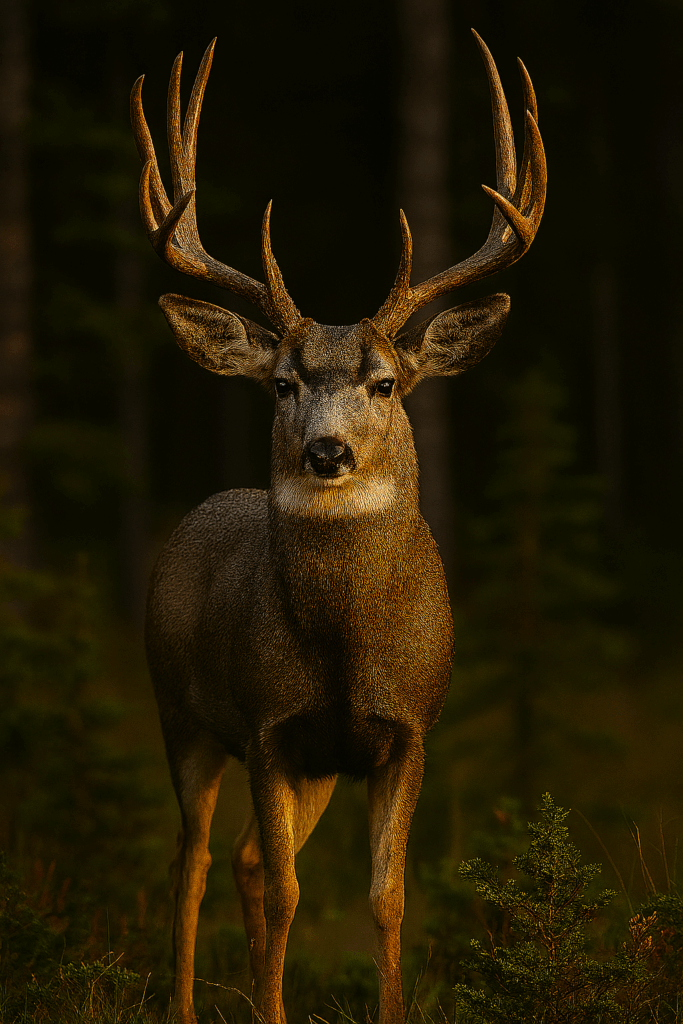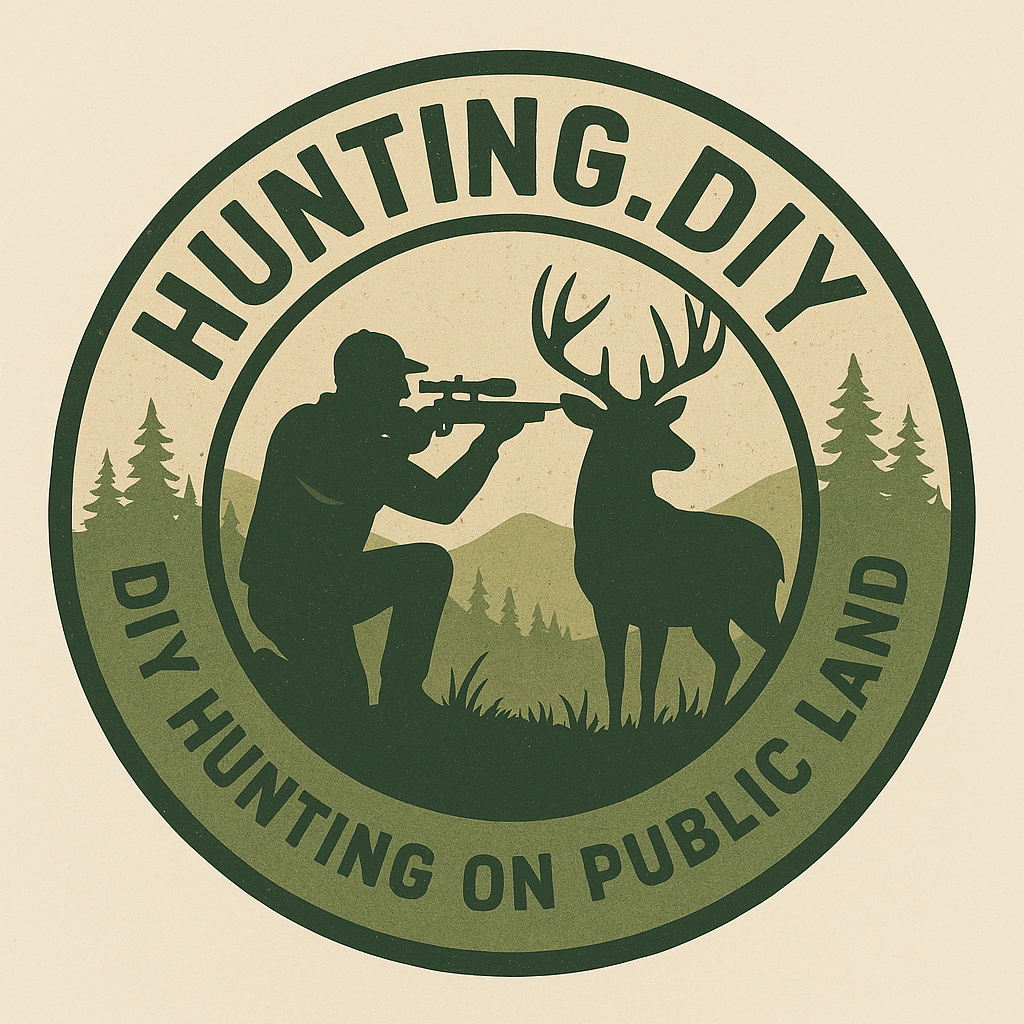Mule Deer DIY Hunting Guide & Tips
Mule deer hunting guide: Get off your couch and into the backcountry—mule deer aren’t going to roll over when you show up. This no-nonsense guide gives you the real deal for tagging your own mule deer on public land without a guide.

Species Classification
Mule deer (Odocoileus hemionus) are one of North America’s premier big-game species. They belong to the Cervidae family, sharing lineage with white-tailed deer and elk, but mule deer are built for the rugged stuff. No corporate outfitters here—this is DIY hunting at its purest, where you learn the rules, outsmart the herd, and earn your venison.
Physical Description
Mule deer stand taller and stockier than their white-tailed cousins, with a shoulder height of 3 to 3.5 feet and weighing up to 300 pounds for big bucks. Their signature feature is their huge, mule-like ears that swivel independently, picking up sounds you won’t hear on your cell phone. Bucks carry bifurcated antlers that fork into two main beams, unlike the single main beam of whitetails. The coat is a dusty brown-gray, turning lighter in winter and darker in summer.
Distribution and Habitat
Mule deer roam from the Yukon down to Mexico, but prime hunting country for DIY warriors is in the western U.S. They favor brushy hillsides, pinyon-juniper woodlands, and alpine meadows above 5,000 feet. Steep canyons and arid basins hold winter herds, while summer herds move into higher elevations. Forget comfort—trail up narrow game trails carved into cliffs where no ATV dares to tread.
Season Dates and Regulations
Season dates vary wildly by state and unit, so get off your butt and check your state wildlife agency website for exact dates. In many Western states, archery kicks off early September, rifle season spans late October through November, and muzzleloader tags fall around December. Never assume—regulations change, and breaking them gets you in more trouble than a busted elk tag.
Best Hunting States/Regions
Colorado, Wyoming, Montana, and Utah lead the pack for public-land mule deer hunts. Colorado’s GMUs in the northwest corner hold trophy bucks but attract hordes of weekend warriors—get there early. Wyoming’s high-country draws fewer crowds and delivers heavyweight bucks. Nevada’s open deserts test your water-fixting skills, while Utah’s rugged red-rock canyons separate the hardcore from the couch potatoes.
Hunting Equipment (Gun and Ammo)
Choose a .270 Winchester or .308 Winchester for versatile, flat-shooting performance out to 300 yards. If you want maximum knockdown power, step up to a .30-06 for those high-altitude one-shot kills. Opt for premium bonded bullets to prevent meat damage. Load up 40 rounds for practice and another 40 for the field—zero your rifle at 200 yards with real hunting ammo before you wander into the wilderness.
Hunting Methods and Techniques
Still-hunting is the name of the game—crawl up the windward side of ridges, glass basins for movement with a spotting scope, then slip in for a shot on a calm morning. Use natural cover like sagebrush and rock outcroppings. Don’t pester every deer you see; pick a mature buck, wait for a broadside quartering-away shot, and squeeze the trigger smooth as you’ll ever be. Glass from midday heat until your eyelids droop—deer feed heavily at dawn and dusk.
Licenses and Tags
DIY hunting means you must know your paperwork. Purchase a general-season tag or apply for limited-entry tags if you crave big horns. Most states offer online sales until a week before season opens—don’t procrastinate or you’ll be eating beans for dinner. Carry your tag, license, and harvest report with you; losing them in the backcountry is a rookie mistake.
Diet and Feeding
Mule deer are browsers and graze on shrubs, forbs, and grasses. In spring and summer, they crave green shoots of aspen and mountain mahogany, while winter forces them onto bitterbrush and sage. Key feeding areas hug water sources—pinpoint springs and seasonal ponds on your topo maps to locate consistent deer traffic.
Reproduction and Life Cycle
Doe breeding season peaks in late November, leading to a mobile, hormone-driven rut scene. Bucks bolt from bachelor groups, chasing does across ridges, leaving sign everywhere. Gestation runs about 200 days, and fawns hit the ground in late May or June. By fall, yearlings trail their mothers, making them fair game, but focus on mature bucks for bragging rights.
Population Status
Mule deer populations fluctuate with weather, predation, and habitat health. Drought years slam fawn survival; severe winters thin herds. Agencies conduct annual aerial and ground surveys—look up their reports to pick units with rising populations. Steer clear of drought-stricken zones if you want a solid chance at a buck.
Meat Quality and Processing
Mule deer meat is lean and mildly sweet. Field dress immediately—gut shot or not, the risk of spoilage in hot weather is real. Quarter the deer on-site and haul out backstraps and hindquarters first. Pack a mesh game bag to discourage maggots and let the meat air-dry. Once home, age in a fridge at 36°F for 3–5 days, then butcher into roasts, steaks, and burger.
Safety Considerations
Never hunt alone in terrain that can kill you. Tell someone your exact unit, entry point, and expected exit date. Carry a GPS beacon or satellite messenger—cell service in mule deer country is a joke. Pack waterproof matches, a first-aid kit, and layers for sudden temperature drops. If you slip and break a leg, you don’t want to rely on a random hiker for rescue.
Tracks and Sign
Watch for the distinct “teardrop” tracks of mule deer, 2 to 3 inches long, with a symmetrically rounded front and pointed back. Rubs scar on pine and juniper up to 5 feet high mark buck territory. Scrapes are open dirt patches beneath overhanging branches—does ignore these, but bucks dip antlers for scent marking. Follow these clues uphill into bedding areas.
Similar Species – How to Distinguish
Mule deer versus white-tailed deer is a rookie mix-up. Mule deer ears nearly swallow their head and antlers fork; white-tails have sleek, shorter ears and main beams with tines off a single beam. In the mountains, elk can look like big mule deer at dusk—note the dark brown neck and squat body shape of mule deer, versus the long legs and pale rump patch of elk. Know your target before you pull the trigger.
Embrace the grind, study the country, and earn every inch of your tag. Mule deer don’t gift themselves to lazy hunters—get after it.
